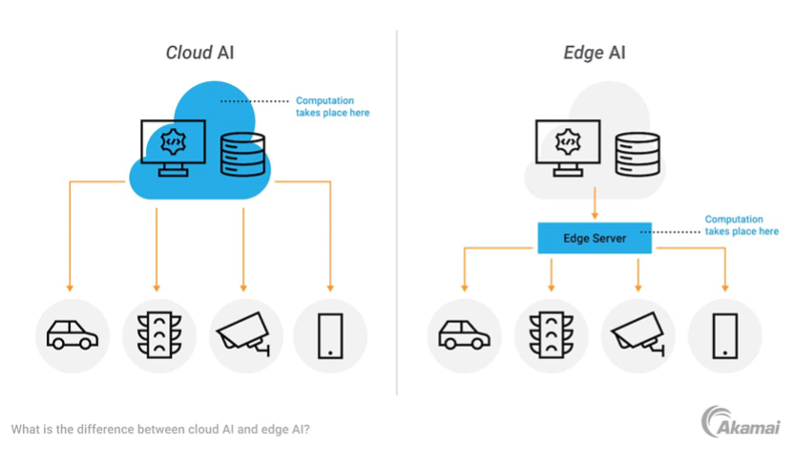AI in Cloud Computing: How AI Is Revolutionizing the Landscape
Contents
Executive summary
- Cloud AI refers to artificial intelligence services and resources hosted on public cloud platforms. These capabilities are used to automate processes, optimize resource allocation, and support a wide range of intelligent functions.
- Edge AI shifts AI workflows, specifically inferencing, from centralized cloud data centers to edge networks, enabling computation closer to where data is generated. This reduces latency and enhances real-time responsiveness and scalability.
- The ability to run AI in a continuum of compute along with cloud services and edge computing will make cloud products and services more efficient, effective, and intuitive.
What is cloud AI?
Cloud AI is the term used to describe the integration of cloud computing with artificial intelligence (AI) technology.
The fusion of AI tools with cloud computing provides a seamless integration of their respective capacities at the end-user level. This can accelerate the transformation of existing services using AI — which is increasingly important as generative AI and machine learning are more broadly adopted by industries, businesses, and individuals, and producing tangible benefits.
According to Fortune Business Insights, AI in cloud computing is expected to see a compound annual growth rate of more than 30% through 2030.
The integration of AI with cloud computing
Cloud AI is, at its most basic interpretation, the locating of artificial intelligence services and resources on public cloud platforms. Within the cloud infrastructure, AI algorithms are used to:
- Automate tasks
- Optimize resource allocation
- Enhance security
- Analyze data, especially with large datasets
- Provide personalized experiences
Among the benefits of this integration is the increased ability to scale cloud services, as well as the ability to draw upon AI insights to improve efficiency.
To help our customers expand their network visibility and ease policy implementation, we added significant enhancements such as AI-based functionalities, wizards, and reports to the process of integrating AI with our cloud platform and edge networks.
Advancements in automation and machine learning
Automation and machine learning algorithms have benefited cloud computing in many significant ways, leading to:
- More efficient resource management
- Intelligent cost optimization
- Improved security
- Greater scalability
- Faster development cycles
- Minimized manual intervention
- Reduced human error
The implementation of AI models also helps streamline the operation of cloud services through analytics, allowing for more informed decision-making.
Elevating data management through AI
One of the most intuitive uses for machine learning and artificial intelligence is data management. Massive datasets can be handled much more efficiently by AI, especially in tasks like anomaly detection and data integration, quality checks, and visualization.
AI’s ability to accurately and rapidly identify trends and patterns through predictive analytics means that richer insights can be gained from data. That allows for better real-time decision-making, which helps lead to optimized outcomes.
AI's role in enhancing cloud services and infrastructure
The same AI technologies that power efficient and effective data management in the cloud are also helping cloud providers enhance their own services and infrastructure.
The automation of tasks is key to making cloud platforms more efficient. The ability to process massive amounts of information in real time improves anomaly detection and enhances security. That effectively makes cloud platforms more intelligent, which results in an increased capacity to manage complex workloads across various cloud applications and services.
Types of cloud computing powered by AI
There are three main cloud environments:
- Public cloud
- Multicloud
- Hybrid cloud
AI has shaped each of these environments in different ways.
Public cloud
Public cloud is the most familiar cloud platform, in which businesses gain access to off-premises data centers through third-party vendors. AI enhances the capabilities of cloud services and products, which makes more powerful capabilities available to those businesses.
Multicloud
A multicloud computing environment involves the practice of using multiple public cloud providers for different purposes — for instance, one to host groupware, another for mobile apps, and so on. Distributing AI workloads among multiple cloud environments maximizes flexibility and scalability. You can access best-in-class cloud tools without being locked into a single AI platform or service.
Hybrid cloud
The hybrid cloud model uses a combination of public and multicloud cloud infrastructures. Similarly, the benefits of AI to hybrid cloud are a combination of the benefits seen for public and multicloud environments. This model provides businesses with more options and allows them to use AI tools in whichever environment will produce the best results.
AI use cases in the cloud
Some examples of the AI use cases that are found in cloud computing include:
- Natural language processing: The ability to interpret language, including unstructured text or data, which can be applied to content moderation and customer support, among other uses
- Chatbots: An extension of natural language processing, chatbots provide an AI-powered point of contact with customers and help streamline interactions and improve customer service
- Data analytics: As previously noted, the ability of AI to process and analyze massive amounts of data provides real-time access to insights that can be used to improve decision-making
AI also offers other benefits like increased efficiency and the ability to boost productivity by streamlining operations and reducing or eliminating human error.
Cloud AI in the real world
Cloud AI isn’t just a background function; end users see real-world results from cloud platforms that use AI to enhance products and services.
An example is how AI contributes to the optimization of the Internet of Things (IoT). Through continuous data monitoring, AI can identify when devices or machines are likely to fail and can alert administrators to the need for action — a process known as predictive maintenance.
What lies ahead: The future of AI in cloud computing
The ongoing integration of AI technologies with cloud services will continue to evolve. The capacity for AI to automate tasks, analyze great quantities of data in real time, and provide advanced analytics means that cloud products and services will become more efficient, more effective, and more intuitive — exactly what it’s doing for end users now, but at greater scale and with enhanced capabilities.
Trying to predict exactly what those capabilities will look like is, of course, a fool’s errand. But one trend that will have a noteworthy impact is the migration of AI tools from cloud data centers to edge servers.
What is edge AI?
The next step is the location of AI in edge computing centers, rather than in cloud data centers. For those who need a quick primer:
- Cloud computing is the ability to acquire and use computing services — servers, storage, databases, networking, software, analytics, intelligence, and more — over the internet.
- Edge computing brings data, insights, and decision-making to the periphery of a network, rather than processing data in a central location that may be thousands of miles away.
Breaking down localized intelligence
Edge AI represents the movement of AI workflows from cloud data centers to edge networks, which allows the computation to happen closer to where data is collected instead of in distant, centralized server farms.
A report from Grand View Research places the 2025 market value of edge AI at US$24.9 billion, with a revenue of US$66.47 billion forecast for 2030. The report found that consumer electronics and IT/telecom represented approximately one-third of the edge AI market in 2024, with automotive, healthcare, and manufacturing representing another third.
Placing AI tools on edge servers reduces the time it takes for data to make the round trip from user to AI and back. IoT and mobile devices are among the use cases that will experience edge AI benefits, since artificial intelligence capabilities will be brought close to or directly to the device, eliminating their reliability on a distantly located data center and allowing for real-time decisions to be made.
Cloud AI vs. edge AI: Understand the differences
To understand the advantages of each of these two implementations, you have to make an AI architecture comparison of both platforms (Figure).
Cloud AI platforms offer scalability; therefore, as demand for processing power increases, that demand can be met on an as-needed basis.
Edge AI platforms bring real-time processing closer to the devices that need it the most. That also means that your data is staying local to you, which can reduce the opportunities for a breach or other cybersecurity threats and can meet compliance requirements.
Both cloud computing and edge AI platforms are accessible to individuals and to businesses of all sizes without the need to invest in infrastructure or hire dedicated talent.
Cloud AI or edge AI? Making the right choice
Which platform will work best for you? As with all technology business decision-making, many factors must be considered. But there are two primary cases — scalability and real-time data — that are good stepping-off points for choosing an AI development strategy.
Scalability: Cloud AI advantages are in sync with the power and flexibility of large data centers. If you need access to immense computational power, if you deal with exceptionally large volumes of data, or if your storage needs spike from time to time, cloud AI has an advantage.
Real-time data: When the AI workloads are moved to edge servers that are closer to end users it dramatically improves processing speeds while making AI data more secure. And if real-time data analysis or ultra-low latency are a concern, then edge AI allows you to process data as close as possible to the end user or device.
The future is here: How cloud and edge AI are shaping tomorrow
Artificial intelligence continues to shape cloud computing through the ability to process massive amounts of data and automate many functions that previously required manual operation. It’s taking an already productive platform and streamlining it, resulting in efficiencies that have measurable impacts on the users of cloud computing platforms.
With the increasing presence of AI on edge servers, the advantages in real-time data analysis include enhancing the functions of IoT and mobile devices that rely more on ultra-low latency and less on sheer processing capacity.
The fact that cloud and edge computing each offer distinct advantages indicates that there will continue to be cloud and edge computing synergy in the future. The move from cloud to edge is likely to play a critical role in the future of AI in cloud computing by enabling AI to achieve exciting new capabilities.
But while the respective advantages of cloud computing and edge computing may become less distinct with each new advance, cloud and edge computing will be synergistic as long as these are the two prevailing models.
Learn more
Explore the shifting landscape of AI compute by reading our white paper based on a 2024 Forrester Consulting study commissioned by Akamai. You'll learn that 76% of cloud decision-makers view distributed cloud as critical to their objectives, and 60% see AI opportunities as a priority.
As AI moves from core cloud functions to edge applications, understanding this transition is essential for enterprise strategies.
Download the white paper to gain valuable information that can help your organization navigate these changes effectively.



